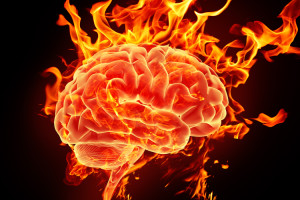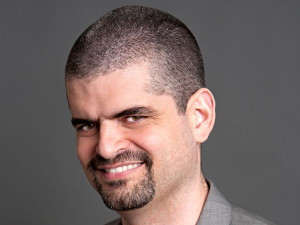By Deepak Chopra, MD and Bernardo Kastrup, PhD
It’s time to make up our minds about the brain. Every day, it seems, neuroscience announces new findings that uncover more and more of the brain’s secrets. The day cannot be far off, we are told, when the deepest mystery of all—how the brain produces consciousness—will be solved. At the risk of raining on everyone’s parade, such a claim may be entirely wrong. Let’s see why.
A recent paper, published in the prestigious journal Cell , poses a central question: “Why does a relentless stream of experiences normally fill your mind?” No one in neuroscience claims to have the answer—yet. This is a very familiar “yet,” a promissory note that says, “Stay tuned. Once we have enough data, consciousness will be explained once and for all.” This promise is the whole point of the Cell article, which sets its sights against the notion that consciousness is a “miracle” whose explanation is ultimately outside scientific investigation. It argues that by using a more sophisticated understanding of brain function, today’s progress will turn into tomorrow’s solution (the authors speak, for example, of awareness arising as the product of “a reciprocal exchange of information across multiple areas in the cerebral cortex.”)
If such steady progress is being made, why was it necessary to write an article defending the whole area of brain research as the key to unraveling the mind? Because the most basic assumption of neuroscience, the platform that supports all the talk about information, neuronal signals, activity in the cortex—literally the whole shebang—is wobbly. Everyone is assuming that the brain produces the mind in the first place. Knocking down this assumption isn’t likely to be funded by the federal government the way it is funneling $100 million into the Brain Activity Map. The only proof that the brain=mind assumption is wrong comes from philosophy, which most scientists, including brain scientists, dismiss out of hand.
How can thinking about the mind be better than gathering hard facts about the brain? Because data only has meaning given a certain way of seeing it. This point was made in the one book almost every college student reads (if they read any) in the philosophy of science,Thomas J. Kuhn’s The Structure of Scientific Revolutions, published in 1962. Kuhn shattered the notion of objective progress in science by arguing that given their starting assumptions, every scientific scheme for explaining Nature—what he called a paradigm—is right on its own terms.
This seminal insight went back to 1947 when Kuhn, then a graduate student at Harvard, was wrestling with how wrong Aristotle had been. Aristotelian physics was the first systematic explanation of Nature in mechanical terms, the cornerstone of Western science that made Copernicus, Newton, and Einstein possible. And yet a brilliant mind like Aristotle’s arrived at completely wrong conclusions about such basic things as why objects fall to earth or what heat is. Suddenly Kuhn had an epiphany: what we call Aristotle’s mistakes in fact weren’t mistakes. If you accept the starting assumptions behind Aristotelian physics, its description of Nature was valid.
Kuhn seemed to be saying that Aristotle was just as right as Newton, which to most people, including probably every scientist, makes no sense. In our time, the acceptance of scientific progress is all but universal, and the triumphs of modern technology are undeniable. Yet no one has rebutted Kuhn’s point that we view Nature through our own paradigm, our worldview, and that the history of science is a constant stream of shifting paradigms, one after another. There is no way to step outside the paradigm you totally believe in.
But what if our current paradigm happens to be absolutely right? A Theory of Everything has been on the horizon for decades, and we are told that it’s only a matter of time before the theory is complete. Kuhn’s point is that an absolutely correct theory, no matter how much data you feed into it, cannot be achieved. All you can achieve is the fulfillment of the paradigm you believe in. Eventually problems will arise that cannot be solved without shattering the present paradigm so that a new one can be formed.
The authors of the Cell article, along with the entire field of neuroscience, anchor their faith on the starting assumption that the mind must be explainable through the brain. They are turning their backs, then, on what the philosophy of science teaches.
1. Theories are right about what they include and wrong about what they exclude.
2. There is no such thing as direct, objective proof about any theory of existence (known in philosophy as ontology).
3. Data has no meaning unless it is interpreted, and interpretations are bound by the observer’s starting assumptions.
These three points are enough to level the playing field when it comes to competing worldviews and scientific paradigms. In a word, everyone has a story, and everyone believes their story. Even contradictory stories can be valid and fit the same data. This startling conclusion applies to any situation where competing stories are told: marriages when they break apart, defendants protesting their innocence in court, and the most sophisticated theories in science. Sticking to your story convinces you that you’re telling the truth when in fact you are just defending a way of seeing.
The starting assumption of neuroscience, that brain=mind, is particularly weak, but that’s the nature of paradigms as they start to crumble around the edges. Their proponents defend them more stoutly. There is absolutely no data to indicate that neurons can think; they merely light up on an fMRI as thinking occurs, which isn’t the same thing. You could construct a setup so that a 100-watt bulb lights up over your head every time you have a bright idea, but that doesn’t mean the light bulb caused the idea. Neuroscience ignores this obvious flaw when it arrives at the same false conclusion, using neurons instead of a light bulb.
The current state of confidence in neuroscience powerfully illustrates the inability of many scientists to step out of a particular way of seeing, regardless of how limited or problematic it may have become. Has science been making progress in understanding consciousness as an outcome of brain function? The authors of the Cell article think so, pointing to promising recent empirical results, all the while ignoring the fact that their interpretation of these results is entirely based on assumptions about the underlying nature of matter, metabolism, and consciousness itself. Thus the authors appear to take for granted that matter exists fundamentally outside consciousness; that metabolism is a purely material process; and that consciousness is somehow generated by metabolism. Were they to set aside their hidden assumptions and look again at the very same results, very different – and no less valid – conclusions could be extracted.
To give a simple example: It is assumed that when a person sees a red apple, the red light is real, in the sense that it exists outside our awareness. Moreover, one can point to activity in the visual cortex when the wavelengths of light corresponding to red strike the retina and get transmitted along the optic nerve. With precise, minute examination, the specific neurons that process color can be described in detail. And there you have it, a red apple is seen as a red apple.
It would baffle many neuroscientists to be told that nothing in this chain of reasoning actually tells us how the color red is perceived in our minds. To begin with, the redness of an apple doesn’t exist independently in Nature. To quote the eminent British neurologist Sir John Eccles, “I want you to realize that there exists no color in the natural world, and no sound – nothing of this kind; no textures, no patterns, no beauty, no scent.” Without a human observer, redness has no existence, nor any other quality we perceive “out there” in the world. This criticism of materialism is bolstered by another realization: No one has made the slightest progress in showing how the brain, a totally dark place filled with electrical and chemical activity, produces the sensation of light, including its colors. Photons are invisible. The quality of brightness is a mental creation. The brain isn’t bright; the visual cortex doesn’t contain a photo album of the images you see; the movie in your mind is projected on no physical screen.
The only thing that keeps alive the promise that the brain will one day explain consciousness is neuroscience’s blindness to any explanation other than the one assumed to be true in advance. The latest experiments in quantum physics have rendered all but untenable the notion that reality exists outside consciousness. (See Kim, Y.-H. et al. (2000) “A Delayed Choice Quantum Eraser,” described in detail in a Wikipedia entry devoted to it. An even stronger stand is taken by Gröblacher, S. et al. in “An experimental test of non-local realism,” which physicsworld.com discussed under the header “quantum physics says goodbye to reality.”). If all of reality is in consciousness, then obviously the brain – as part of reality – is also in consciousness, not consciousness in the brain. As such, a different way of seeing is required under which the brain is merely the image of particular processes in consciousness; the brain is not the generator of consciousness.
We said that the same data about the brain can be fruitfully interpreted through a new way of seeing, or what Kuhn would call a new paradigm. The next post in this series will explain how a new interpretation might work. Until mind comes first, neuroscience is like a car speeding downhill, exhilarated by the ride but not seeing the brick wall it’s heading toward around the next bend.
Photo Credit: Viktoriya via Shutterstock
(To be cont.)
Deepak Chopra, MD is the author of more than 80 books with twenty-two New York Times bestsellers including Super Brain, co-authored with Rudi Tanzi, PhD. He serves as the founder of The Chopra Foundation and co-founder of The Chopra Center for Wellbeing.
 Bernardo Kastrup has a Ph.D. in Computer Engineering and has worked as a scientist in some of the world’s foremost research laboratories, including the European Organization for Nuclear Research (CERN) and the Philips Research Laboratories (where the “Casimir Effect” of Quantum Field Theory was discovered). He has authored many scientific papers and four philosophy books: Rationalist Spirituality, Dreamed up Reality, Meaning in Absurdity, and Why Materialism Is Baloney. This latter book is a grand synthesis of his metaphysical views. Bernardo has also been an entrepreneur and founder of two high-tech businesses. Today, he holds a managerial position in the high-tech industry. In parallel, he maintains a philosophy blog, an audio/video podcast, and continues to develop his ideas about the nature of reality. Bernardo has lived and worked in four different countries across continents. He currently resides in the Netherlands.
Bernardo Kastrup has a Ph.D. in Computer Engineering and has worked as a scientist in some of the world’s foremost research laboratories, including the European Organization for Nuclear Research (CERN) and the Philips Research Laboratories (where the “Casimir Effect” of Quantum Field Theory was discovered). He has authored many scientific papers and four philosophy books: Rationalist Spirituality, Dreamed up Reality, Meaning in Absurdity, and Why Materialism Is Baloney. This latter book is a grand synthesis of his metaphysical views. Bernardo has also been an entrepreneur and founder of two high-tech businesses. Today, he holds a managerial position in the high-tech industry. In parallel, he maintains a philosophy blog, an audio/video podcast, and continues to develop his ideas about the nature of reality. Bernardo has lived and worked in four different countries across continents. He currently resides in the Netherlands.
